TRIBAL ART
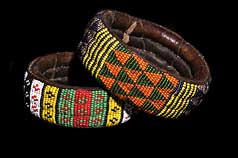
|
TRIBAL ART  |
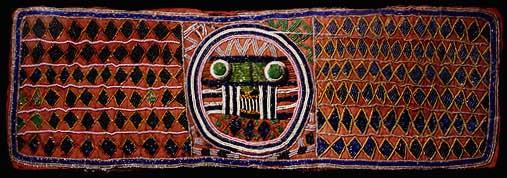 |
|
TRIBAL ART HAVE BEEN CULLED FROM THE MOST RESPECTED, PRESTIGIOUS, AND RELIABLE AMERICAN SOURCES: JAMES WILLIS TRIBAL ART GALLERY DAVE DEROCHE LENARD KAHAN GALLERY MUSEUM OF AFRICAN ART; BELGRADE PROVENANCE ALSO INCLUDES SELECT NEW YORK AND SAN FRANCISCO EXHIBITIONS AND CONTRIBUTIONS FROM RALPH KIEHLO and BULLY NIMAGA; NIGERIA A
COMPLIMENTARY
WRITTEN APPRAISAL OF THESE PIECES FROM "JAMES WILLIS TRIBAL ART" IS AVAILABLE UPON REQUEST |
| |
| YORUBA IBEJI STATUE PROVENANCE: GALLERY DEROCHE, EX-COLLECTION RALPH KIEHLO "MAMI WADDA CULT" SHRINE FIGURE CLICK THIS TITLE FOR ADDITIONAL PHOTOGRAPHS |
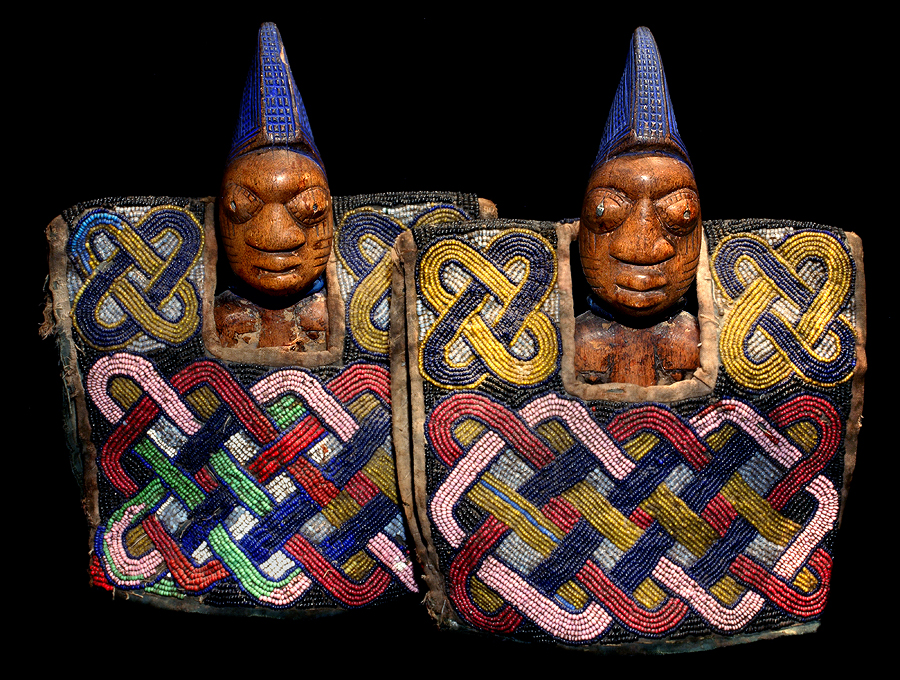 |
| IBEJI STATUE TWIN PAIR IN
MATCHING BEADED TWIN JACKET PAIR PROVENANCE: LENARD KAHAN GALLERY, 560 BROADWAY, N.Y. N.Y. 10012 EXHIBITED: Kahan Gallery, NYC: 1992 JAMES WILLIS TRIBAL ART APPRAISAL 1993: 1637 TAYLOR STREET, SAN FRANCISCO, CA. 94133 EXHIBITED: MUSEUM OF AFRICAN ART; 14 ANDRE NIKOLICA STREET, BELGRADE: 2015 PUBLISHED MUSEUM CATALOGUE "IBEJI SCULPTURE" MUSEUM OF AFRICAN ART; BELGRADE: 2015 |
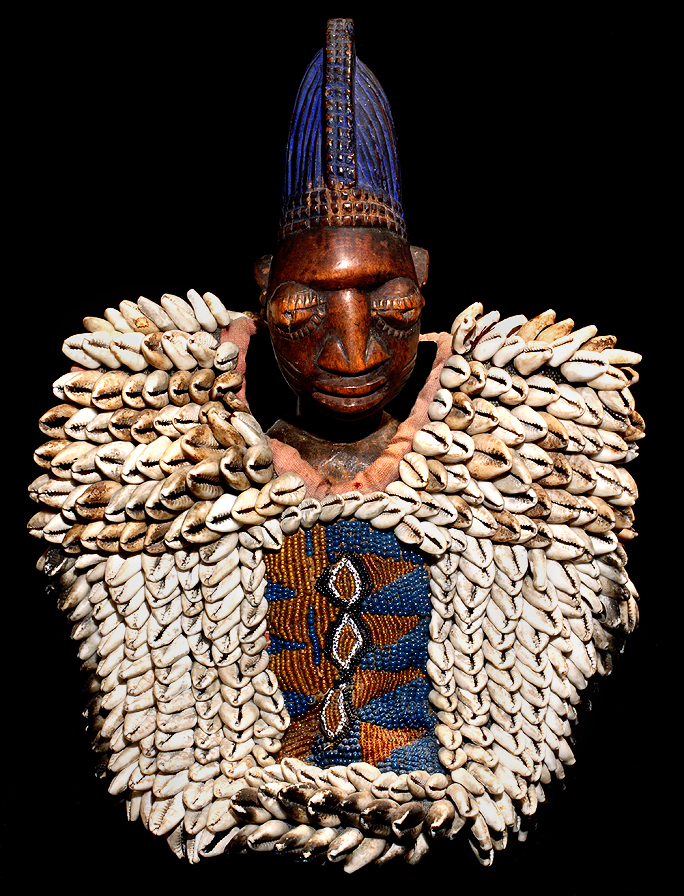 |
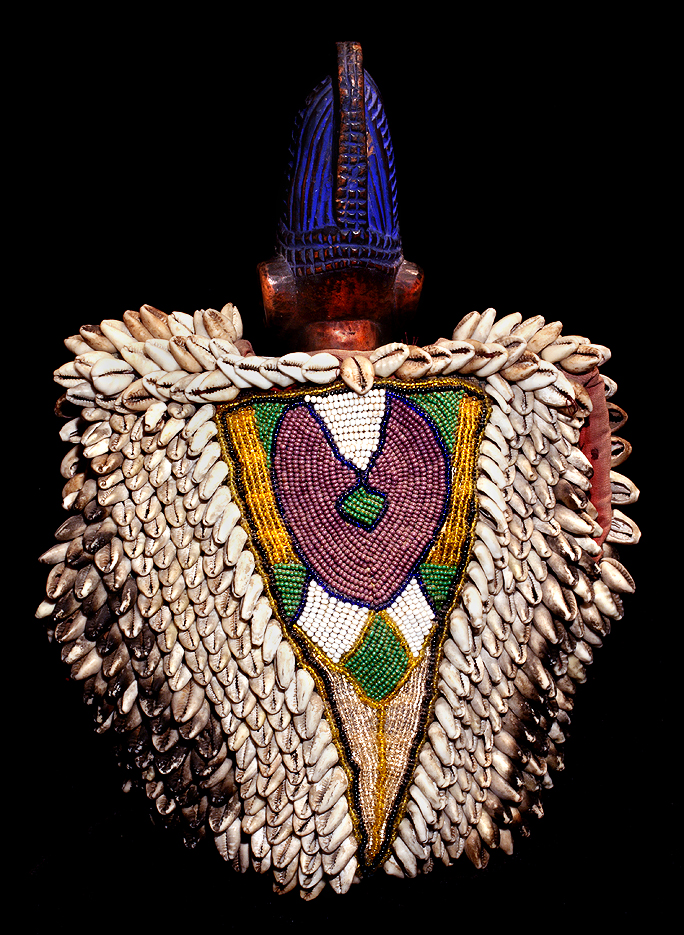 |
 |
| IBEJI STATUE IN COWRIE
SHELL BEADED JACKET PROVENANCE: FOLKLORICA GALLERY, 89 5th AVENUE, N.Y. N.Y. 10003 EXHIBITED: Folklorica Gallery, NYC: 1991 JAMES WILLIS TRIBAL ART APPRAISAL 1993: 1637 TAYLOR STREET, S.F. 94133 EXHIBITED: MUSEUM OF AFRICAN ART; 14 ANDRE NIKOLICA STREET, BELGRADE: 2015 PUBLISHED MUSEUM CATALOGUE "IBEJI SCULPTURE" MUSEUM OF AFRICAN ART; BELGRADE: 2015 |
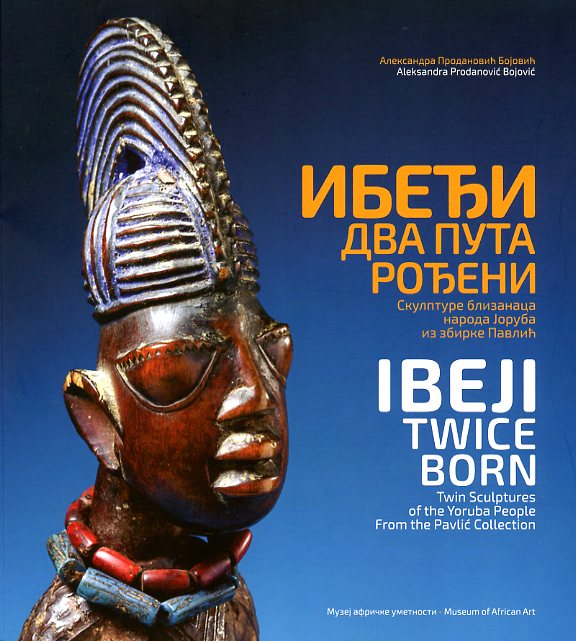 |
"IBEJI TWICE BORN" MUSEUM OF AFRICAN ART EXHIBITION CATALOGUE PUBLISHED: MUSEUM OF AFRICAN ART; BELGRADE: 2015 DAVID HOWARD'S TRIBAL ART AND PHOTOGRAPHY FEATURED ON PAGES 83 AND 86 |
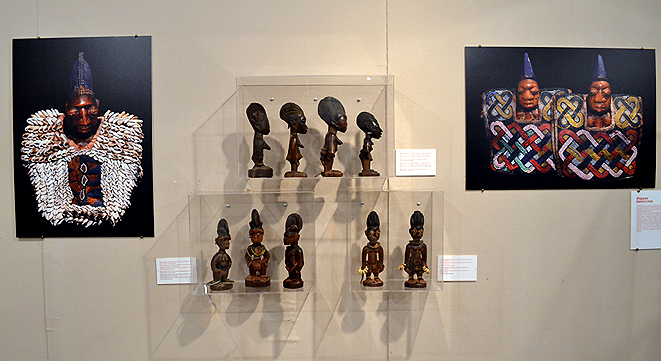 |
"IBEJI TWICE BORN" MUSEUM OF AFRICAN ART EXHIBITION DISPLAY PUBLISHED MUSEUM CATALOGUE "IBEJI SCULPTURE" MUSEUM OF AFRICAN ART; BELGRADE: 2015 |
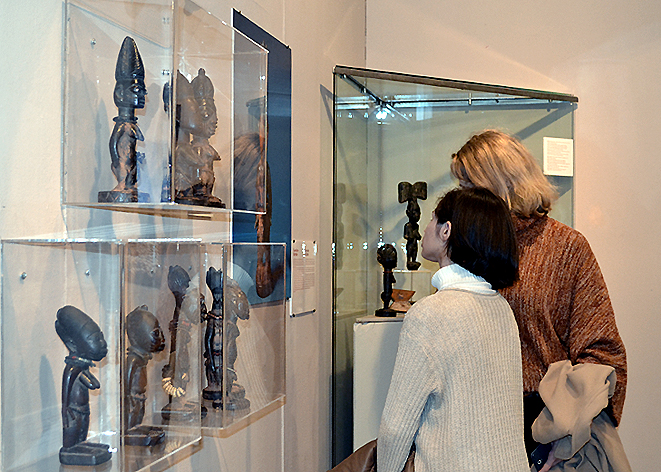 |
"IBEJI TWICE BORN" MUSEUM OF AFRICAN ART EXHIBITION OPENING DECEMBER 2015 PUBLISHED MUSEUM CATALOGUE "IBEJI SCULPTURE" MUSEUM OF AFRICAN ART; BELGRADE |
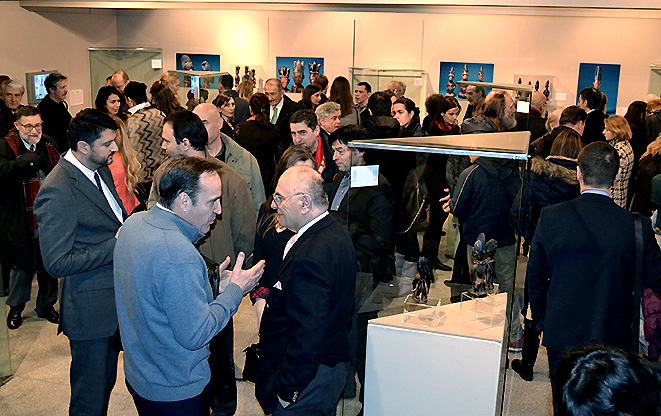 |
"IBEJI TWICE BORN" MUSEUM OF AFRICAN ART EXHIBITION OPENING DECEMBER 2015 PUBLISHED MUSEUM CATALOGUE "IBEJI SCULPTURE" MUSEUM OF AFRICAN ART; BELGRADE |
 |
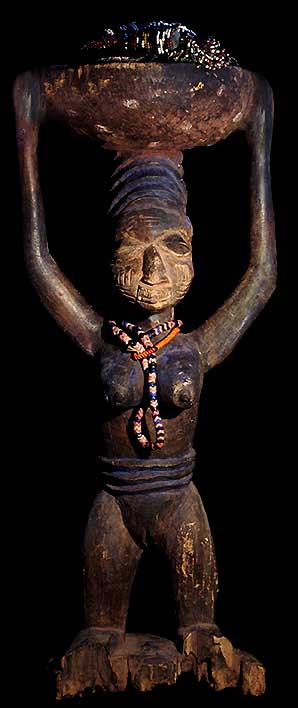 |
 |
| SHANGO BAG PROVENANCE: JAMES WILLIS GALLERY EXHIBITED: Willis Gallery 1991 |
DIVINATION ALTER AND NECKLACE PROVENANCE: GALLERY DEROCHE |
DIVINATION NECKLACE PROVENANCE: BULLY NIMAGA; NIGERIA |
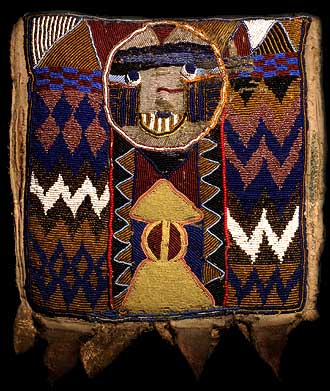 |
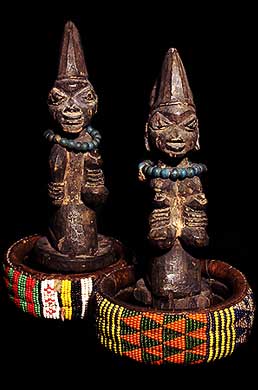 |
| RITUAL BEADED BAG PROVENANCE: LENARD KAHAN GALLERY EXHIBITED: Kahan Gallery 1991 |
ESHU DANCE STAFF FIGURES & TWO BEADED BRACELETS |
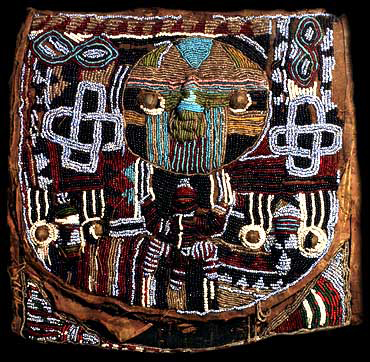 |
| SHANGO
RITUAL BEADED BAG PROVENANCE: BULLY NIMAGA; NIGERIA |
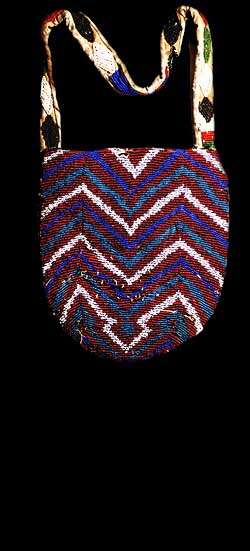 |
 |
| CEREMONIAL BEADED BAG PROVENANCE: BULLY NIMAGA; NIGERIA |
FLY WHISK PROVENANCE: BULLY NIMAGA |
|
NIGERIAN
YORUBA TRIBAL BEADED REGALIA IS RESERVED FOR, AND USED ONLY BY, ROYALS
AND
THE TRIBE'S "IFA" SHAMANS. PERFORMANCE OF DIVINATION RITUALS AND SACRED
CEREMONIES
IS THE PRIMARY RELIGIOUS "BABLAWO" FUNCTION OF AN IFA PRIEST. SACRED
BEADED
ICONOGRAPHY ON "APO IFA" CEREMONIAL BAGS, NECKLACES, AND
VESTMENTS
ARE WORN DURING IMPORTANT TRIBAL RITUALS. THESE ICONS ARE CONCEPTUAL SYMBOLS THAT SIGNIFY A VARIETY OF SPIRITUAL REMEDIES THAT REDIRECT NEGATIVE MYSTICAL
POWERS INTO POSITIVE RESULTS. THIS EXTREMELY VISUAL CEREMONIAL
BEADED REGALIA IS DESIGNED TO BE VIEWED FROM VARIOUS DISTANCES AND
FOCAL
LENGTHS, WHICH ENCOURAGES THE DEVOTEES' INTERPRETATION AND PERCEPTION
OF
SACRED BEADED ICONS IN A VARIETY OF DIFFERENT WAYS WHEN VIEWED FROM
DIVERGENT
ANGELS OR VANTAGE POINTS. THE "AGEMO" CHAMELEON IS PERHAPS THE MOST
COMMON
BEADED YORUBA ICON AS THAT REPTILE IS AN ELEMENT OF THE MOST POTENT TRIBAL MEDICINE. SACRED
CEREMONIAL YORUBA BEADED REGALIA ICONOGRAPHY NOT ONLY COMMUNICATES RANK AND
RELIGIOUS AFFILIATION OF IFA PRIESTS,
BUT MORE IMPORTANTLY; AN ENDLESS PERPETUAL LOOP OF TRIBAL MYTHOLOGY: A
BELIEF
STRUCTURE IS CONCEPTUALLY REFLECTED BACK ON TO ITSELF, WHEN
PRACTITIONERS INFLUENCE AND ABSORB THE ENDLESS CYCLE OF RE-EMERGING
ICONIC SYMBOLIC ARCHETYPES
THAT CONTAIN AN ABSTRACT VISUAL UNDERSTANDING AND EXPLANATION FOR THE
YORUBA'S
SPIRITUAL COSMOS.
The Yoruba present the highest dizygotic twinning rate in the world (4.4% of all maternities). They manifest at 45–50 twin sets (or 90–100 twins) per 1,000 live births, possibly because of high consumption of a specific type of yam containing a natural phytoestrogen which may stimulate the ovaries to release an egg from each side. Twins are very important for the Yoruba and they usually tend to give special names to each twin. The first of the twins to be born is traditionally named Taiyewo or Tayewo, which means 'the first to taste the world', or the 'slave to the second twin', this is often shortened to Taiwo, Taiye or Taye. The Yorùbá religion comprises the traditional religious and spiritual concepts and practices of the Yoruba people. One of the most common Yoruba traditional religious concepts has been the concept of Orisha. Orisha (also spelled Orisa or Orixa) are various godly forms, that reflect one of the various manifestations / avatars of God in the Yoruba spiritual or religious system. Some widely known Orisha are Ogun, (God of metal, war and victory), Shango or Jakuta (God of thunder, lightening, fire and justice who manifests as a king always wielding a double-edged axe which conveys his Ashe or divine authority & power), Esu/Eshu elegbara (The trickster and sole messenger to the pantheon, who conveys the wish of men to the gods. He understands every language / tongue spoken by humankind, and is also the guardian of the crossroads, Oríta méta in Yoruba). Eshu has two avatar forms which are manifestations of his dual nature- positive and negative energies; Eshu Laroye, a teacher instructor and leader, and Eshu Ebita, jesty, deceitful, suggestive and cunning, Orunmila, The god of Infinite Knowledge, divination, wisdom and fortune-telling, who reveals the past, solution to problems in the present, and the future, consulted through the "Ifa" divination system by oracles called Babalawos. Olorun is one of the manifestations / avatars of the Supreme God of the Yoruba pantheon, the owner of the heavens, and is associated with the Sun known as Oòrùn in the Yoruba language. The other two avatar forms of the supreme God are; Olodumare, the supreme creator and Olofin, who is the conduit between Òrunn (Heaven) and Ayé (Earth), Oshumare a god that manifests in the form of a rainbow, also known as Òsùmàrè in Yorùbá, Obatala god of clarity and creativity Etc. This religion has found its way throughout the world and is now expressed in practices as varied as Candomblé in Brazil, Lucumí/Santería in Cuba and North America, Shango in Trinidad (Trinidad Orisha), Anago and Oyotunji, as well as in some aspects of Umbanda, Winti, Obeah, Vodun and a host of others. These varieties, or spiritual lineages as they are called, are practiced throughout areas of Nigeria, the Republic of Benin, Togo, Brazil, Cuba, Guyana, Haiti, Jamaica, Puerto Rico, Suriname, Trinidad and Tobago, the United States, Uruguay, Argentina and Venezuela, among others. As interest in African indigenous religions grows, Orisha communities and lineages can be found in parts of Europe and Asia as well. While estimates may vary, some scholars believe that there could be more than 100 million adherents of this spiritual tradition worldwide. Oral history of the Oyo-Yoruba recounts Odùduwà to be the Progenitor of the Yoruba and the reigning ancestor of their crowned kings. His coming from the east, sometimes understood by some sources as the "vicinity" true East on the Cardinal points, but more likely signifying the region of Ekiti and Okun sub-communities in northeastern Yorubaland/central Nigeria. Ekiti is near the confluence of the Niger and Benue rivers, and is where the Yoruba language is presumed to have separated from related ethno-linguistic groups like Igala, Igbo, and Edo. After the death of Oduduwa, there was a dispersal of his children from Ife to found other kingdoms. Each child made his or her mark in the subsequent urbanization and consolidation of the Yoruba confederacy of kingdoms, with each kingdom tracing its origin due to them to Ile-Ife. After the dispersal, the aborigines became difficult, and constituted a serious threat to the survival of Ife. Thought to be survivors of the old occupants of the land before the arrival of Oduduwa, these people now turned themselves into marauders. They would come to town in costumes made of raffia with terrible and fearsome appearances, and burn down houses and loot the markets. Then came Moremi on the scene; she was said to have played a significant role in the quelling of the marauders advancements. But this was at a great price; having to give up her only son Oluorogbo. The reward for her patriotism and selflessness was not to be reaped in one life time as she later passed on and was thereafter immortalized. The Edi festival celebrates this feat amongst her Yoruba descendants. Yoruba culture consists of folk/cultural philosophy, religion and folktales. They are embodied in Ifa-Ife Divination, known as the tripartite Book of Enlightenment in Yorubaland and in its diaspora. Yoruba cultural thought is a witness of two epochs. The first epoch is a history of cosmogony and cosmology. This is also an epoch-making history in the oral culture during which time Oduduwa was the head, the Bringer of Light, and a prominent diviner. He pondered the visible and invisible worlds, reminiscing about cosmogony, cosmology, and the mythological creatures in the visible and invisible worlds. The second epoch is the epoch of metaphysical discourse. This commenced in the 19th century in terms of the academic prowess of Bishop Dr. Ajayi Crowther. Although religion is often first in Yoruba culture, nonetheless, it is the thought of man that actually leads spiritual consciousness (ori) to the creation and the practice of religion. Thus, it is believed that thought is an antecedent to religion. Today, the academic and nonacademic communities are becoming more interested in Yoruba culture. More research is being carried out on Yoruba cultural thought as more books are being written on the subject. Medieval Yoruba settlements were surrounded with massive mud walls. Yoruba buildings had similar plans to the Ashanti shrines, but with verandahs around the court. The wall materials comprised puddled mud and palm oil while roofing materials ranged from thatches to aluminium and corrugated iron sheets. A famous Yoruba fortification, the Sungbo's Eredo was the second largest wall edifice in Africa. The structure was built in the 9th, 10th and 11th centuries in honour of a traditional aristrocat, the Oloye Bilikisu Sungbo. It was made up of sprawling mud walls and the valleys that surrounded the town of Ijebu-Ode in Ogun State. Sungbo's Eredo is the largest pre-colonial monument in Africa, larger than the Great Pyramid or Great Zimbabwe. The Yorubas worked with a wide array of materials in their art including; bronze, leather, terracotta, ivory, textiles, copper, stone, carved wood, brass, ceramics and glass. A unique feature of Yoruba art, is their striking realism-which unlike most African art, choose to create human sculptures in vivid realistic and life sized forms. The art history of the nearby Benin empire show that there was a cross - fertilization of ideas between the neighboring Yoruba and the Edo. The Benin court's brass casters learned their art from an Ife master named Iguegha, who had been sent from Ife around 1400 at the request of Benin's oba Oguola. Indeed, the earliest dated cast-brass memorial heads from Benin replicate the refined naturalism of the Yoruba sculptures from Ife. A lot of Yoruba artworks, including staffs, court dress, and beadwork for crowns, are associated with palaces and the royal courts. The courts also commissioned numerous architectural objects such as veranda posts, gates, and doors that are embellished with carvings. Yoruba palaces are usually built with thicker walls, are dedicated to the gods and play significant spiritual roles. Yoruba art is also manifested in shrines and masking traditions. The shrines dedicated to these gods are adorned with carvings and house and array of altar figures and other ritual paraphernalia. Masking traditions vary by region, and diverse mask types are used in various festivals and celebrations. Aspects of Yoruba traditional architecture has also found its way into the New World in the form of shortgun houses. One of the first observations of first time visitors to Yorubaland is the rich, pomp and ceremonial nature of their culture, which is made even more visible by the urbanized structures of Yoruba settlements. These occasions are avenues to experience the richness of the Yoruba culture. Traditional musicians are always on hand to grace the occasions with heavy rhythms and extremely advanced percussion which the Yorubas are well known for world over. Praise singers and Griots are there to add their historical insight to the meaning and significance of the ceremony, and of course the varieties of colorful dresses and attires worn by the people, attest to the aesthetic sense of the average Yoruba. The Yoruba are a very expressive people who celebrate major events with colorful festivals and celebrations (Ayeye). Some of these festivals (about thirteen principal ones) are secular and only mark achievements and milestones in the achievement of mankind, these include wedding ceremonies (Ìgbéyàwó), Naming ceremonies (Ìsomolórúko), Funerals (Ìsìnkú), Housewarming (Ìsílé), New-Yam festival (Ìjesu), Odon itsu in Atakpame, Harvest ceremonies (Ìkórè), Birth (Ìbí), Chieftaincy (Ìjòyè) and so forth.[76] Others have a more spiritual connotation, such as the various days and celebrations dedicated to Specific Orisha like the Ogun day (Ojó Ògún), The Osun festival, which is usually done at the Osun-Osogbo sacred grove located on the banks of the Osun river and around the ancient town of Osogbo. The festival is dedicated to the river goddess Osun, which is usually celebrated in the month of August (Osù Ògùn) yearly. The festival attracts thousands of Osun worshippers from all over Yorubaland and The Yoruba diaspora in the Americas, spectators and tourists from all walks of life. The Osun-Osogbo Festival is a two-week-long programme. It starts with the traditional cleansing of the town called 'Iwopopo', which is then followed in three days by the lighting of the 500-year-old sixteen-point lamp called Ina Olojumerindinlogun, which literally means The sixteen eyed fire, the lighting of this sacred lamp, heralds the beginning of the Osun festival. Then comes the 'Ibroriade', an assemblage of the crowns of the past ruler, Ataojas of Osogbo, for blessings. This event is led by the sitting Ataoja of Osogbo and the Arugba Yeye Osun (who is usually a young maiden dressed in white, who carries a sacred white calabash that contains propitiation materials meant for the goddess Osun, she is also accompanied by a committee of priestesses. A similar event holds in the New World as Odunde Festival. |
|
|
| |
Asian tribal art, artifacts, ifugao, kalinga, bontoc,
asmat, dayak, philippines, asia, head hunters, human trophy skull,
skulls, african, antiques, naga, necklace, headdress, head hunting
trophy skull, Indonesia, Indonesian, SOUTHEAST ASIA, Borneo, Sarawak,
ANTIQUES, Kalimantan, Sulawesi, ART, Sumatra, Timor, ARTIFACTS, Bali,
Java, INDIA, Flores, Sumba, NEPAL, Savu, Roti, BABAS, Lombok, Malaysia.
HOLY MEN, Nusa Tengara, New Guinea, SHAMAN, Irian Jaya, Moluccas,
CONTEMPORARY ART, Tanimbar, Leti, OLD, Lembata, Alor, MINILA,
Philippines, Luzon, PALAWAN, Mindanao, Sulu, BLOW GUN, Southeast Asia,
Asia, NOSE RING, Asian, Burma, HAT, Myanmar, India, SWORD, Nagaland,
Nepal, KNIFE, Tibet, Himalaya, MOUNTAIN, Himalayan, Assam, TRIBES,
Thailand, Vietnam, YAO, Yunnan, Hainan,
HMONG, China, Central Asia, ZAO, Dayak, Batak, BAG, Toraja, Naga,
POLE, Chin, Li, QUIVER, Miao, Bahau, MASK, Punan, Penan, MODELED SKULL,
Modang,
Kayan, BRASS COIL, Kenyah, Ngaju, COILS, Kontu, Kantu, TEXTILE, Iban,
Maloh, PRIEST, Tunjung, Busang, RITUAL, Aoheng, Dong Son, MYSTICAL
Konyak, Tangkhul, MYSTIC, Ao, Angami, PRIMITIVE, Sema, Wancho, HAND
MADE,
Bontoc, B'laan, ARTIST, Bagabo, Gaddang, BULUL, Ifugao. Sculpture,
BULULS, statue, mask, BOX, beadwork, bead, AUTHENTIC, textile, weaving,
TRIBAL,
costume, hat, WOODEN, shield, spear, WOOD, helmet, sword, BOAR, charm,
fetish, FEATHERS, drum, basket, FEATHER, basketry, jewelry, SILVER,
ornament, weapon, ASMAT Canoe, amulet, decoration, SCULPTURAL,
architecture, architectural, SCULPTURE, longhouse, headhunter, SKULL,
headhunting,
shaman, TRIBAL, festival, ceremony, ceremonial, SHAMAN ritual, tattoo,
HEAD HUNTER Skull, dragon, hornbill, HEADDRES, art, tribal, VIETNAM,
tribe,
culture, TRIBES, cultural, myth, TRIBAL, artifact, artefact, REAL,
wood, stone, HAND WOVEN, cotton, metal, CAST bronze, brass, cloth,
ISLAND, tropics, tropical, EQUATOR, ethnographic, EQUATORIAL, Tribal
Art,
Primitive Art, Ethnographic Art, Oceanic Art, Folk Art, Ethnic
Cultures,
AUTHENTIC Artifacts, Textiles, ANCIENT, Costumes, Sculpture,
SCULPTURES,
Masks, Beadwork, BEADS, Fetishes, Charms, GOLD Jewelry, Baskets,
BAMBOO,
Weapons, Shields, ORNATE, Indonesia, Borneo, PUPPETS, Sumatra,
Sulawese,
SHADOW PUPPET, Java, Bali, CAVE, Timor, Flores, ISLAND, Sumba. Lombok,
VILLAGE, Molucca, Philippines, RICE TERRACE, Luzon, Mindanao, DAVID
HOWARD
PHOTOGRAPHY, Nepal, Burma, SACRED JOURNEY: THE GANGES TO THE HIMALAYAS,
Thailand, THE LAST FILIPINO HEAD HUNTERS, Laos, Vietnam, TEN SOUTHEAST
ASIAN
TRIBES FROM FIVE COUNTRIES, India, Central Asia, NECKLACES, Southeast
Asia,
Dayak, STATUE, lban, Kayan, INK STAMP, Kenyah, Modang, FEATHERED,
Bahau, Ngaju, HORSE, Batak, Toraja, NAGALAND, Naga, Dong Song. TRIBAL
ART, AUTHENTIC PRIMITIVE ART, OLD ETHNOGRAPHIC ART, RARE OCEANIC ART,
BEAUTIFUL FOLK ART, ETHNIC CULTURES, TRIBAL ARTIFACTS, TEXTILES,
ASIAN,
COSTUMES, SCULPTURE, WOOD MASKS, BEADWORK, CHARMS, FETISHES, SIVER
JEWELRY BOXES, BASKETS, WEAPONS, FILIPINO SHIELDS, INDONESIA, BORNEO,
ETHNOGRAPHIC, SUMATRA, SULAWESE, TRIBAL, JAVA, BALI, TRIBES, TIMOR,
FLORES, ASIAN,
SUMBA. LOMBOK, TRIBES, MOLUCCA, PHILIPPINES, TRIBAL, LUZON, ASIAN,
MINDANAO, NEPAL, ASIA, BURMA, THAILAND, TRIBAL, LAOS, VIETNAM, TRIBES,
INDIA,
CENTRAL TRIBAL ASIA, ARTIFACTS, SOUTHEAST ASIA, HEAD HUNTER, DAYAK,
ASIAN, IBAN, KAYAN, TRIBE, KENYAH, MODANG, TRIBAL, BAHAU, NGAJU, ASIAN,
BATAK, TORAJA, TRIBE, NAGA, tribal art, ASIAN, primitive art, ASIA,
ethnographic
art, TRIBAL, oceanic art, ASIAN folk art, SOUTHEAST ASIA ethnic
cultures,
artifacts, ASIAN, textiles, costumes, VILLAGE sculpture, masks, TRIBAL
beadwork, fetishes, TRIBES charms. jewelry, TRIBE, baskets, weapons,
TRIBAL,
shields, indonesia, ASIAN, borneo. sumatra, TRIBAL ART sulawese, java,
HILL TRIBE, bali, timor, ASIAN, flores, sumba, TRIBES, lombok, molucca,
BULUL STATUES philippines, luzon, ISLAND ART, mindanao, nepal, ASIA,
burma, thailand, JOURNEY laos, vietnam, TRIBAL, india, central asia,
TRIBE, southeast asia, OLD ART, dayak. lban, TRIBES, kayan, kenyah,
ASIAN, modang, bahau, AUTHENTIC TRIBAL ART, ngaju, batak, HEADDRESS,
toraja, naga, MOUNTAIN PROVINCE, dong song, KALINGA, Indonesia,
Indonesian, IFUGAO, Borneo, Sarawak, BONTOC, Kalimantan, Sulawesi,
TRIBAL, Sumatra,
Timor, ASIAN, Bali, Java, OLD TRIBAL ART
Flores, Sumba, Savu, Roti, Lombok, Malaysia. Nusa Tengara, New Guinea,
Irian Jaya, Moluccas, Tanimbar, Leti, Lembata, Alor, Philippines,
Luzon, Mindanao, Sulu, Southeast Asia, Asia, Asian, Burma. Myanmar,
India, Nagaland, Nepal, Tibet, Himalaya, Himalayan, Assam, Thailand,
Vietnam, Yunnan, Hainan, China, Central Asia, Dayak, Batak, Toraja,
Naga, Chin, Li, Miao, Bahau, Punan, Penan, Modang, Kayan. Kenyah,
Ngaju, Kontu, Kantu, Iban, Maloh, Tunjung, Busang, Aoheng, Dong Son,
Konyak, Tangkhul, Ao, Angami, Sema, Wancho, Bontoc, B'laan, Bagabo,
Gaddang, Ifugao. Sculpture, statue, mask, beadwork, bead, textile,
weaving, costume, hat, shield, spear, helmet, sword, charm, fetish,
drum, basket, basketry, jewelry, ornament, weapon. Canoe, amulet,
decoration, architecture, architectural, longhouse, headhunter,
headhunting,
shaman, festival, ceremony, ceremonial, ritual, tattoo. Skull, dragon,
hornbill, art, tribal, tribe, culture, cultural, myth, artifact,
artefact, wood, stone, cotton, metal, bronze, brass, cloth, tropics,
tropical, ethnographic,
primitive, art, masks, asian, ethnographic, oceanic, folk, ethnic
cultures,
artifacts, Bahau, Kalimantan, indonesia, borneo, sumatra. sulawese,
java, bali, timor. flores, sumba, lombok, molucca, philippines, luzon,
mindanao, nepal, burma, thailand, laos, vietnam, india, central asia,
southeast. dayak, lban, kayan, kenyah, modang, bahau, ngaju, batak.
toraja, naga, dong song. Myanmar, Burma, Kachin, Naga, Konyak, Chin,
Ao, Wancho, Thangkul, Dao, Helmet, Hat, Hornbill, Mizo, Sema, Assam,
India, Mithan, Maram, Morung, Myth, Dream, Post, Pillar, Panel,
Architecture,
Architectural, Tusk, Hill Tribe, Sacrifice, Skull, War Path, Ritual.
Spirit, Figure, Motif, Design, Ceremony, Ceremonial, Raid, Fur, Claws,
Teeth, Fangs, Carving, Statue, Sculpture, Kalinga, Ifugao, Luzon,
Mindanao, T'boli, Bagabo, B'laan, Sulu, Philippines, Weaving, Blouse,
Skirt, Sarong, Shawl, Necklace, Bracelet, Conch Shell, Shell, Brass,
Spear.
Feather, House, Tradition, Traditional, Ancestor, Cloth, Ikat, Chapan,
Uzbek, Asia, Turkoman, Turkamen, Dragon, Snake, Bird, Gong, Island,
Indonesia, Indonesian, Borneo, Sarawak, Kalimantan, Sulawesi, Sumatra,
Timor, Bali, Java, Flores, Sumba, Savu, Roti, Lombok, Malaysia. Nusa
Tengara, New Guinea, Irian Jaya, Moluccas, Tanimbar, Leti, Lembata,
Alor, Philippines, Luzon, Mindanao, Sulu, Southeast Asia, Asia, Asian,
Burma. Myanmar, India, Nagaland, Nepal, Tibet, Himalaya, Himalayan,
Assam, Thailand, Vietnam, Yunnan, Hainan, China, Central Asia, Dayak,
Batak, Toraja, Naga, Chin, Li, Miao, Bahau, Punan, Penan, Modang,
Kayan.
Kenyah, Ngaju, Kontu, Kantu, Iban, Maloh, Tunjung, Busang, Aoheng,
Dong Son, Konyak, Tangkhul, Ao, Angami, Sema, Wancho, Bontoc, B'laan,
Bagabo, Gaddang, Ifugao. Sculpture, statue, mask, beadwork, bead,
textile, weaving, costume, hat, shield, spear, helmet, sword, charm,
fetish, drum, basket, basketry, jewelry, ornament, weapon. Canoe,
amulet, decoration, architecture, architectural, longhouse, headhunter,
headhunting, shaman, festival, ceremony, ceremonial, ritual, tattoo.
Skull, dragon, hornbill, art, tribal, tribe, culture, cultural, myth,
artifact, artefact, wood,
stone, Indonesia, Indonesian, Borneo, Sarawak, Kalimantan, Sulawesi,
Sumatra, Timor, Bali, Java, Flores, Sumba, Savu, Roti, Lombok,
Malaysia. Nusa Tengara, New Guinea, Irian Jaya, Moluccas, Tanimbar,
Leti, Lembata, Alor, Philippines, Luzon, Mindanao, Sulu, Southeast
Asia, Asia, Asian, Burma. Myanmar, India, Nagaland, Nepal, Tibet,
Himalaya, Himalayan, Assam, Thailand, Vietnam, Yunnan, Hainan, China,
Central Asia, Dayak, Batak, Toraja, Naga, Chin, Li, Miao, Bahau, Punan,
Penan, Modang, Kayan. Kenyah, Ngaju, Kontu, Kantu, Iban, Maloh,
Tunjung, Busang, Aoheng, Dong Son, Konyak, Tangkhul, Ao, Angami, Sema,
Wancho, Bontoc, B'laan, Bagabo, Gaddang, Ifugao. Sculpture, statue,
mask, beadwork, bead, textile, weaving, costume, hat, shield, spear,
helmet, sword, charm, fetish, drum, basket, basketry, jewelry,
ornament, weapon. Canoe, amulet, decoration, architecture,
architectural, longhouse, headhunter, headhunting, shaman, festival,
ceremony, ceremonial, ritual, tattoo. Skull, dragon, hornbill, art,
tribal,
tribe, culture, cultural, myth, artifact, artefact, wood, stone,
cotton,
metal, bronze, brass, cloth, tropics, tropical, ethnographic.
Japan, Japanese, shrine, Masks, tsuba, kabuto, mempo, Dayak, Indonesian, sculpture, Indian Cola, Tibetan Thanka, Batak. Timor, Nias, African, Oceanic, Philippines, Luzon, Ifagao, Batak, Dyak, Nias, Bul'ul, artifacts, authentic, antique, asian, asia, expert, dealer, sell, buy, Los Angeles, California, JAPAN, JAPANESE. SHRINE, MASKS, TSUBA, KABUTO, MEMPO, DAYAK. INDONESIAN, SCULPTURE, INDIAN COLA, TIBETAN THANKA, BATAK, TIMOR, NIAS, AFRICAN, OCEANIC. PHILIPPINES, LUZON, IFAGAO, BATAK, DYAK, NIAS, BUL'UL, ARTIFACTS, AUTHENTIC, ANTIQUE, ASIAN, ASIA, EXPERT, DEALER, SELL, BUY, Japan, Japanese, Shrine, Masks, Tsuba, Kabuto, Mempo, Dayak, Indonesian, Sculpture. Indian Cola, Tibetan Thanka, Batak, Timor, Nias, African, Oceanic, Philippines, Luzon, Ifagao, Batak, Dyak, Nias, Bul'ul, Artifacts, Authentic, Antique, Asian, Asia, Expert, Dealer, Sell, Buy, japan, japanese, shrine, masks, tsuba, kabuto, mempo, dayak, indonesian, sculpture, indian cola, tibetan thanka, batak, timor, nias, african, oceanic, philippines, luzon, ifagao, batak, dyak, nias, bul'ul, artifacts, authentic, antique, asian, asia
Japan, Japanese, shrine,
Masks, tsuba, kabuto, mempo, Dayak, Indonesian, sculpture, Indian Cola,
Tibetan
Thanka, Batak. Timor, Nias, African, Oceanic, Philippines, Luzon,
Ifagao,
Batak, Dyak, Nias, Bul'ul, artifacts, authentic, antique, asian, asia,
expert, dealer, sell, buy, Los Angeles, California, JAPAN, JAPANESE.
SHRINE,
MASKS, TSUBA, KABUTO, MEMPO, DAYAK. INDONESIAN, SCULPTURE, INDIAN COLA,
TIBETAN THANKA, BATAK, TIMOR, NIAS, AFRICAN, OCEANIC. PHILIPPINES,
LUZON,
IFAGAO, BATAK, DYAK, NIAS, BUL'UL, ARTIFACTS, AUTHENTIC, ANTIQUE,
ASIAN,
ASIA, EXPERT, DEALER, SELL, BUY, Japan, Japanese, Shrine, Masks, Tsuba,
Kabuto, Mempo, Dayak, Indonesian, Sculpture. Indian Cola, Tibetan
Thanka,
Batak, Timor, Nias, African, Oceanic, Philippines, Luzon, Ifagao,
Batak,
Dyak, Nias, Bul'ul, Artifacts, Authentic, Antique, Asian, Asia, Expert,
Dealer, Sell, Buy, japan, japanese, shrine, masks, tsuba, kabuto,
mempo,
dayak, indonesian, sculpture, indian cola, tibetan thanka, batak,
timor, nias, african, oceanic, philippines, luzon, ifagao, batak, dyak,
nias,
bul'ul, artifacts, authentic, antique, asian, asia
David Howard, David Howard
Tribal Art, art, artist, photography, photographic, photographs,
print, prints, director, producer, exhibitions, exhibits, exhibit,
painting, paint, studio, studios, etching, silkscreens, silkscreen,
contemporary art, Pop Art, artist's story, journal, video, videos,
documentary, documentaries, books, book, asian, asia, Filipino,
Philippines, Sacred Journey, author, The Last Filipino Head Hunters,
collections, collectables, collectable, archives, archive, art, fine,
contemporary, video, dvd, documentary, Keith Haring, Nam June Paik,
Christo, Lowell Nesbitt, Lawrence Ferlinghetti, Charles Arnoldi,
artists, studio visit, artist, program, sculpture, painting,
photography, prints, print,
photo, paintings, sculptures, keith haring, christo, david howard, nam
june
paik, artseen, videos tape, programs, documentaries, arts, world, san
francisco,
new york, los angeles
ANDY WARHOL, JOSEPH ALBERS, ELLSWORTH KELLY, CLAES
OLDENBURG,
ROBERT MOTHERWELL, FRANK STELLA, JAMES ROSENQUIST, ROBERT RAUSCHENBURG,
KEITH
HARING, CHRISTO, ROBERT INDIANA, ROY LICHTENSTEIN, ROBERT MAPPLETHORPE,
ALICE
NEAL, ARTISTS, ART, ARTIST, PAINTING, SCULPTURE, PHOTOGRAPHY, SITE
SPECIFIC,
NAM JUNE PAIK, KENNY SCHARF, LOWELL NESBITT, LAWRENCE FERLINGHETTI,
ARMAN
ARMAN, CHARLES ARNOLDI, CHRIS BURDEN, ART STUDIOS, VIRTUAL REALITY,
ABSTRACT
EXPRESSIONISM, PRINT MAKING, ETCHING, PAINTING, HOLOGRAPHY, AFRICAN
ART,
WOODCARVING, MURAL. MURALS, COMPUTER ART, FIGURATIVE EXPRESSIONISM,
IMPRESSIONISM,
MULTI-MEDIA, MULTI MEDIA